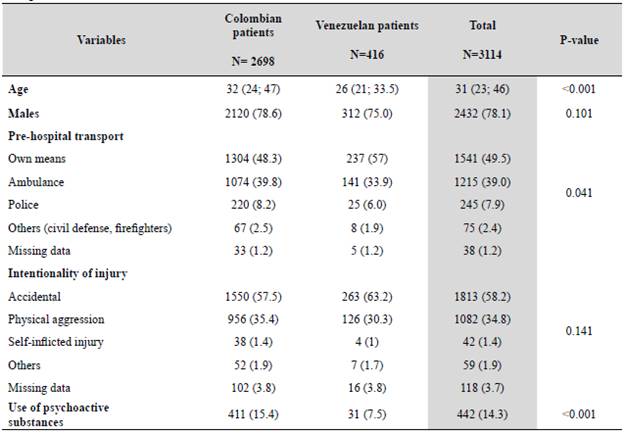Dear Editor,
In recent years, the immigration of Venezuelan citizens to the Republic of Colombia has increased1. Although some research has shown a difference in the presentation of medical conditions in these individuals, there are still no studies evaluating the epidemiology of trauma in this population2,3. The objective of the present study was to compare the characteristics of trauma in the native Colombian population versus the Venezuelan immigrant population using the Institutional Trauma Registry of the Hospital Universitario de Santander (RITHUS) in its first year of implementation.
A prospective cohort study was conducted. All patients with external-cause injuries managed in the Adult Emergency Department of the Hospital Universitario de Santander (HUS) from September 1, 2020, to July 31, 2021, were included. Categorical variables were expressed as absolute values and proportions, while continuous variables were reported as medians and quartiles 1 and 3. The X2 test was used to evaluate differences between categorical variables, and Student's t-test and Mann Whitney U test for quantitative variables, according to their distribution. Finally, a logistic regression model was used to evaluate the presence of an association between Venezuelan migrant status and the risk of in-hospital mortality associated with trauma. An a level of 0.05 (bilateral) was considered statistically significant. The data set was constructed and analyzed using Stata/MP, version 16.0 (StataCorp, College Station, Texas).
Of the total of 3,114 patients included, 416 (13%) were of Venezuelan nationality. Their median age was 26 years, which was significantly lower than that of the national patients (32 years) (p<0.001). In addition, Venezuelan immigrants consulted more frequently by their own means (i.e., on foot, by private vehicle or taxi) compared to Colombians (80.9% vs. 72.4%, p = 0.036). The median prehospital time of these patients was 2.4 hours (Q1:1.1; Q3:15.6), which was not significantly different from the Colombian counterpart (P-value=0.277). No differences were found regarding sex, type of admission (referred or direct) or type of violence (physical, psychological or sexual abuse). Additionally, the Venezuelan patients had a lower consumption of psychoactive substances associated with trauma (P<0.001) (Table 1).
Table 1 Baseline characteristics of patients presenting to the emergency department with external-cause injuries, stratified by immigrant status.

This table contains the % for categorical variables and the median (first and third quartiles) for continuous variables.
The most frequently observed mechanism of trauma was penetrating trauma (41.8%; n = 1,302), with stab wounds being the most frequent (24.9%; n = 776). On the other hand, in 1,299 patients (41.7%), blunt trauma was the only mechanism of injury, with falls from height (18.9%; n = 587), and traffic accidents (16.3%; n = 508) being the most common types of trauma in this group. Finally, mixed trauma (concomitant penetrating and blunt) was recorded in 207 patients (6.6%). No significant differences by nationality were observed in terms of the mechanism of injury. However, Venezuelan migrants had a significantly higher incidence of blunt weapon injuries than Colombian patients (12.3% vs. 9%; p=0.032), this difference being independent of sex, age and intentionality of injury (OR 1.51; 95% CI 1.08-2.12). No other significant differences were observed by type of injury. Regarding trauma severity, the mean Revised Trauma Score (RTS) in Venezuelan migrants was significantly higher compared to Colombian patients (7.74 ± 0.55 vs. 7.62 ± 0.86; p=0.001). The median hospital stay for the entire cohort was two days (Q1: 0; Q3: 4), with no significant differences by nationality (p=0.144). Finally, the risk of mortality was similar in both groups after adjusting for age, sex, intention of injury and mechanism of trauma (OR 0.34; 95% CI 0.11-1.09).
The results of the present study highlight the important disparities in the epidemiology of trauma according to migrant status in Colombia, observing similarities with what has been reported in other studies conducted internationally in refugee populations. First, the finding of a significantly lower median age in Venezuelan migrants compared to the native population is in line with what has been reported in the literature in the field of trauma4,5.
On the other hand, there were no significant differences in the mechanism of trauma or the intentionality of the injury between the two populations. This finding is in opposition to what has been reported in other studies, which describe a higher risk of stab or firearm injuries in the migrant population4,7. Furthermore, differences in trauma severity in migrant populations have been widely debated in the literature, with divergent results regarding injury severity according to migrant status. These differences can potentially be associated with diverse cultural and social contexts, which limits the extrapolation of results from individual studies4,7-9.
In conclusion, Venezuelan migrants admitted to the emergency department for an external cause injury present a significantly different sociodemographic and clinical profile than Colombian nationals, which highlights the need to further evaluate the social and economic conditions behind these findings, as well as to generate public health policies that consider migrant populations.











 text in
text in 



